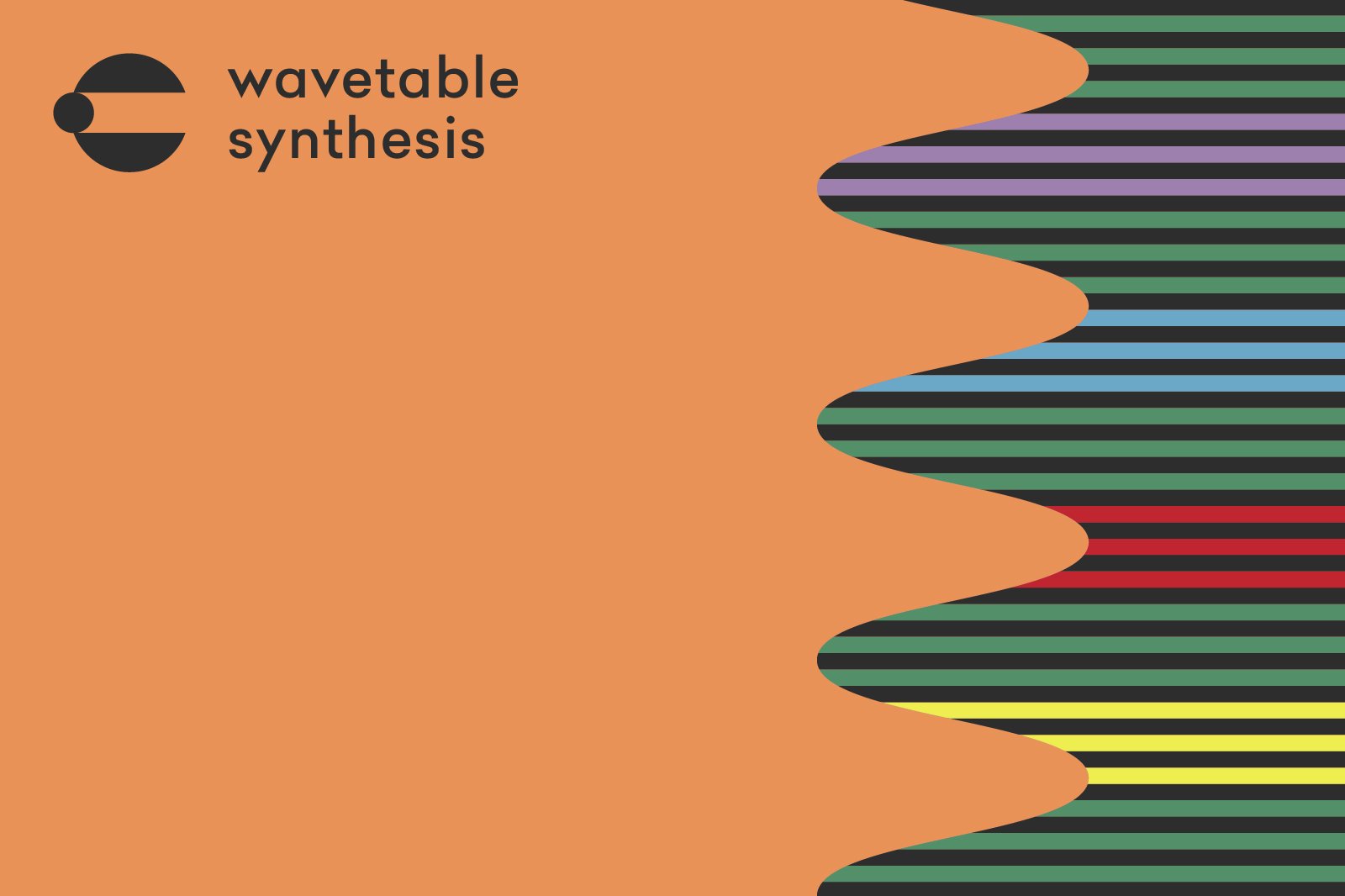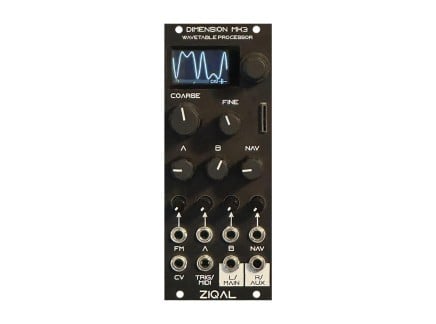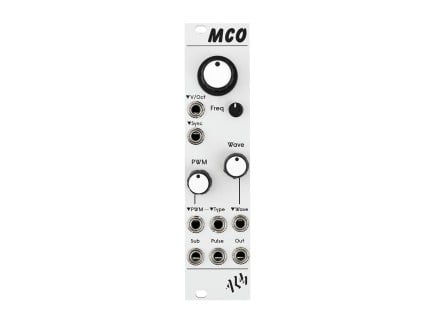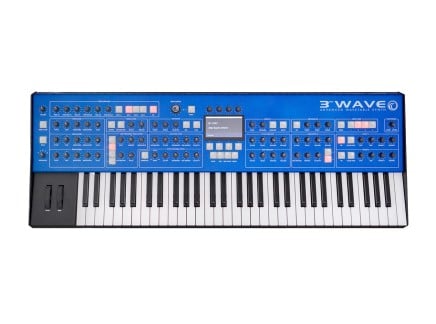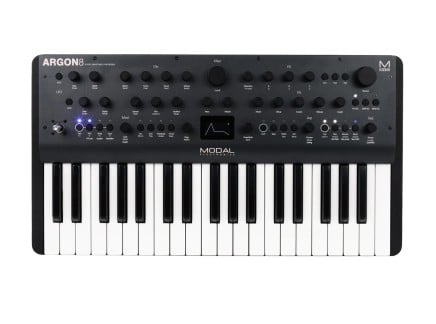The evolution of sound synthesis has come a long way, and in today's world, we are fortunate to have a wide variety of different approaches—each a portal to a distinctly unique sonic realm. In this abundance of options, wavetable synthesis is one of the most flexible and powerful sound design frameworks in the digital domain.
For several decades now, it has been implemented in an extensive range of prized software and hardware instruments—including Native Instruments Massive, Xfer Records Serum, the PPG Wave, Waldorf Microwave, and the Access Virus. Wavetable synthesis is often noted for its distinctly modern sonic aesthetic, and uncommonly powerful features. Needless to say, it plays an integral role in shaping the landscape of contemporary electronic music.
In this article, we are going to delve into the world of wavetable synthesis and examine the scope of its potential. Starting with the basic definition of the approach, we will proceed to discuss its origins, and evolution through several instruments that were either entirely based on it, or in one way or another incorporated the method into their design. By the end of the article, you will have a clear picture of what makes wavetable synthesis unique among other methods, and have a general sense of what you can do with it.
What is Wavetable Synthesis?
Before we dive into the discussion of the synthesis aspect of the approach, let's first define what exactly a wavetable is. As it happens, the term may have two possible meanings.
In the less common definition of the two, a wavetable refers to a fixed-size lookup table filled with a sequence of values. These values represent the amplitude changes of a wave within a single cycle. Scanning through these values at audio rate renders an audible waveform, and by manipulating these values we can change its shape—alter the timbre of the sound. The second (and now prevalent) definition specifies that a wavetable as a collection of pre-recorded single-cycle waveforms (aka waves) connected together, accompanied by a digital interpolation algorithm that allows for seamless transitions between them—either manually or via modulation sources such as LFOs and envelopes. This parameter is commonly dabbed as wavetable position.
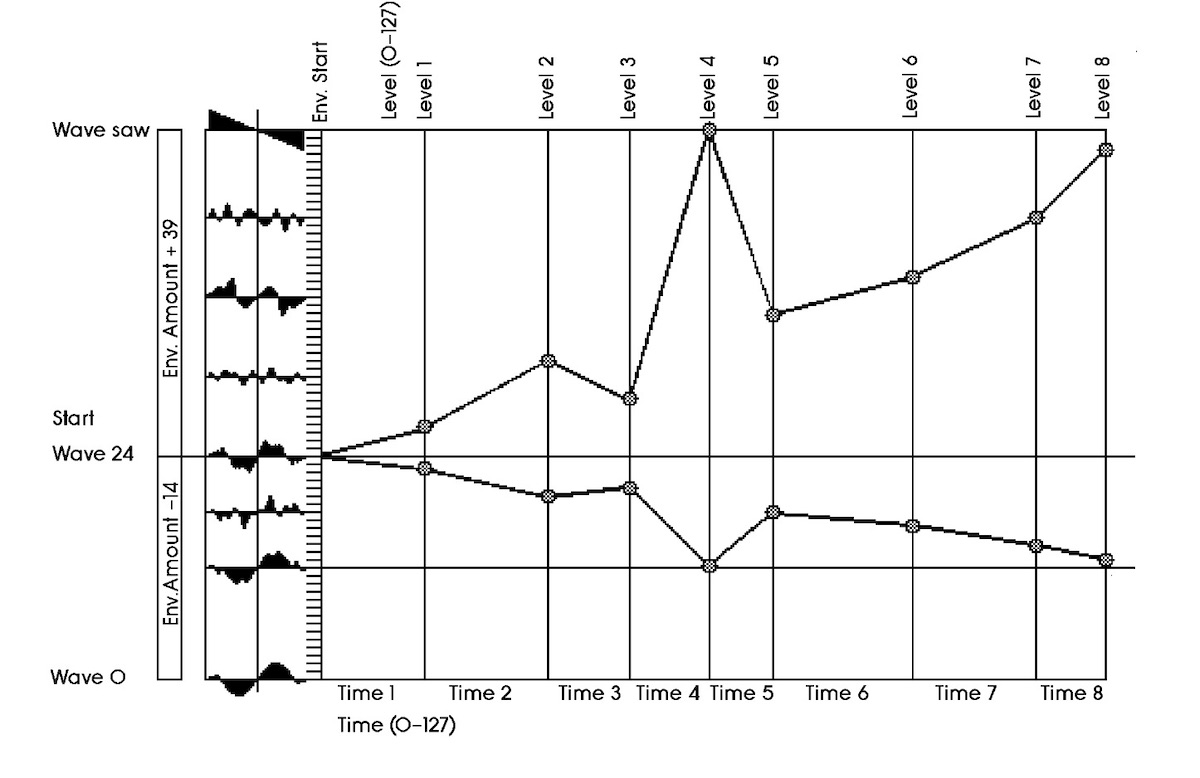
[Above: Details from the Waldorf Microwave programming manual, regarding the process of using multi-segment envelopes to scan wavetable position.]
Whether a synthesizer uses one method or the other is up to the designer. However, it is worth noting that while the former definition describes the concept as it was originally conceived, the latter is a more accurate representation of how wavetable synthesis has been implemented since the 1980s.
Wavetable vs. Sample-Based Techniques
Furthermore, it is important to address a common misconception regarding wavetable synthesis, as it is often mixed up with sample-based synthesis or its most recent variation, wave-sequencing synthesis. The confusion is understandable, as there certainly are similarities between these methods—each uses a sort of pre-recorded or pre-stored sound wave as a basis for synthesis, but there are a number of differences.
Sample-based synthesis first emerged commercially with instruments like Fairlight CMI and the New England Digital Synclavier (each pictured above), which could take any recorded sound of arbitrary length and through a variety of processes transform it into something else, i.e. creating a digital flute out of a short whistle recording, or percussion hits out of rattling kitchen utensils. It is important to underline the arbitrarily of the durational aspect of the recorded sound here, as it is mostly determined by the storage capacity of the technology utilized. In older instruments, like the ones mentioned above, these sounds were rather short, but modern samplers such as Elektron Digitakt and Octatrack can handle much larger sound files, expanding the possibilities of the method. Additionally, since you can use any sound from the real world, the aspect of pitch is relative, and it is usually dealt with and adjusted in the process of synthesis.
In wavetable synthesis, the source is always a collection of single-cycle waveforms—all preconfigured to the same base frequency, so that when you are interpolating or jumping between them, only the harmonic balance is changing, with the pitch is controlled separately via a keyboard, arpeggiator, a sequencer or altogether. Even if the instrument allows you to load any sound of any length (i.e. Ableton's Wavetable), behind the scene it does actually convert a small fraction of it into a stream of single-cycle waveforms.
Also worth mentioning is that over the years different manufacturers have developed variations on wavetable synthesis, and as such, the approach is occasionally delivered under different names including multiple wavetable synthesis, vector synthesis, wavetable modification algorithm, and digital wave synthesis. All these terms indicate certain nuanced modifications of the method, with occasional overlaps between the wavetable, and other forms of sound synthesis. Occasionally a term may encapsulate a mixture of certain design novelties of a particular instrument and a sprinkle of marketing language maneuvers used to differentiate one synthesizer from another.
Traditionally, wavetable-based synthesizers come stocked with curated sets of wavetables, and it is not too uncommon for an instrument to support the integration of custom user wavetables for an even wider and more personalized sonic range. Although historically the process of creating custom wavetables has been tedious, and required dedicated hardware editors, in today's world it is much more streamlined, and there are freely available software solutions created entirely for this purpose. In some cases, like again in Ableton's Wavetable instrument, the instrument allows you to simply drop any audio file, and all the conversion and adjustment are taken care of under the hood.
Moreover, wavetables don't always have to be static waveforms (meaning having a fixed set of values), there are certain methods developed which are enable generating dynamically changing wavetables. For example, the wavetable engine in the renowned graphic-synth software Metasynth allows you to freely draw wave shapes. Another example is the scanned synthesis method implemented in the Qu-Bit Electronix Scanned Eurorack module, where a slow-running dynamical system is excited, and scanned at an audio rate blossoming into a wealth of naturally changing and evolving tones.
As you can see, the oscillator is the defining element in wavetable synthesis. It is at the heart of any wavetable-based instrument, while the rest of the design commonly borrows techniques from other established approaches to sound synthesis, namely subtractive, as well as frequency/phase and amplitude modulation.
The Origins of Wavetable Synthesis
Despite its association with a modern sound, wavetable synthesis preceded even the arrival of the first analog synthesizers of Moog and Buchla. The invention of the method is credited to the computer music pioneer Max Mathews, who came up with it during his work on the second generation of his revolutionary MUSIC N program in 1958. Excited by the prospect of making music with a computer exemplified by MUSIC I, yet unsatisfied with the range of sounds it was capable of, Mathews set out to expand the available timbral range and polyphony in MUSIC II.
As a result, the new version of the software was equipped with a brand new wavetable oscillator capable of producing sixteen different wave shapes, and up to four voices could be played simultaneously. Certainly, the inventor's idea was quite ahead of its time, and it would take a couple of decades before the first digital synthesizers that could take advantage of it would start to appear.
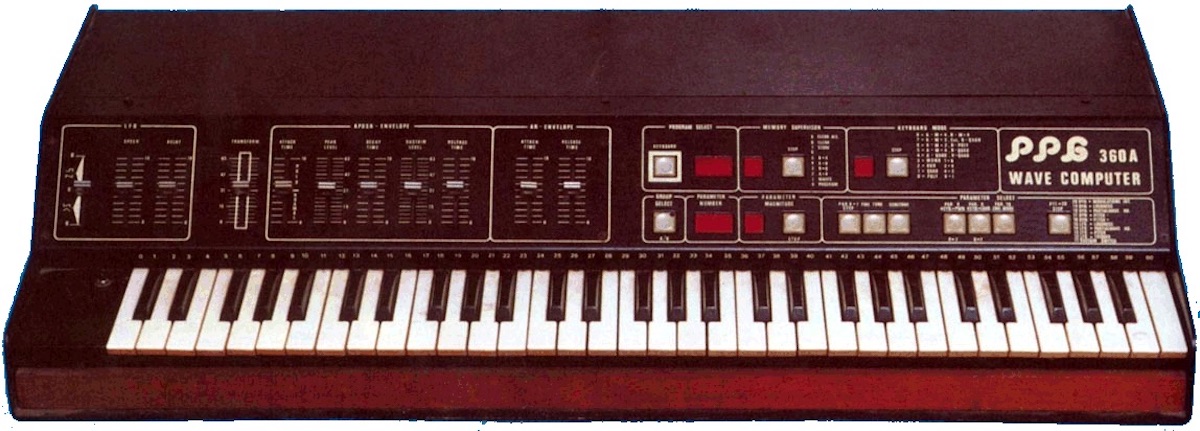
[Above: picture of the PPG Wavecomputer 360A, via ppgsynth.net]
The development of wavetable synthesis in a form that is familiar to us today is attributed to the pioneering work of German synthesizer designer Wolfgang Palm. Throughout the 1970s, Palm formulated his own version of the wavetable synthesis, and in 1980 he released the first wavetable-based digital hardware synthesizer, the Wavecomputer 360 (pictured above) under the brand name PPG (Palm Products GmbH). The instrument was available in two versions, with either four or eight voices, however, its limited polyphony, and reportedly “thin” sound didn’t earn it much attention.
However, things changed when PPG released its second synth in 1981, the iconic Wave. The digital oscillators in the new instrument featured thirty wavetables, each offering sixty-four distinct waveforms—much more than any analog synthesizer at the time was capable of. Moreover, the instrument included a selection of analog modulation sources and characterful filters that added warmth and color to counterpart digital oscillators.
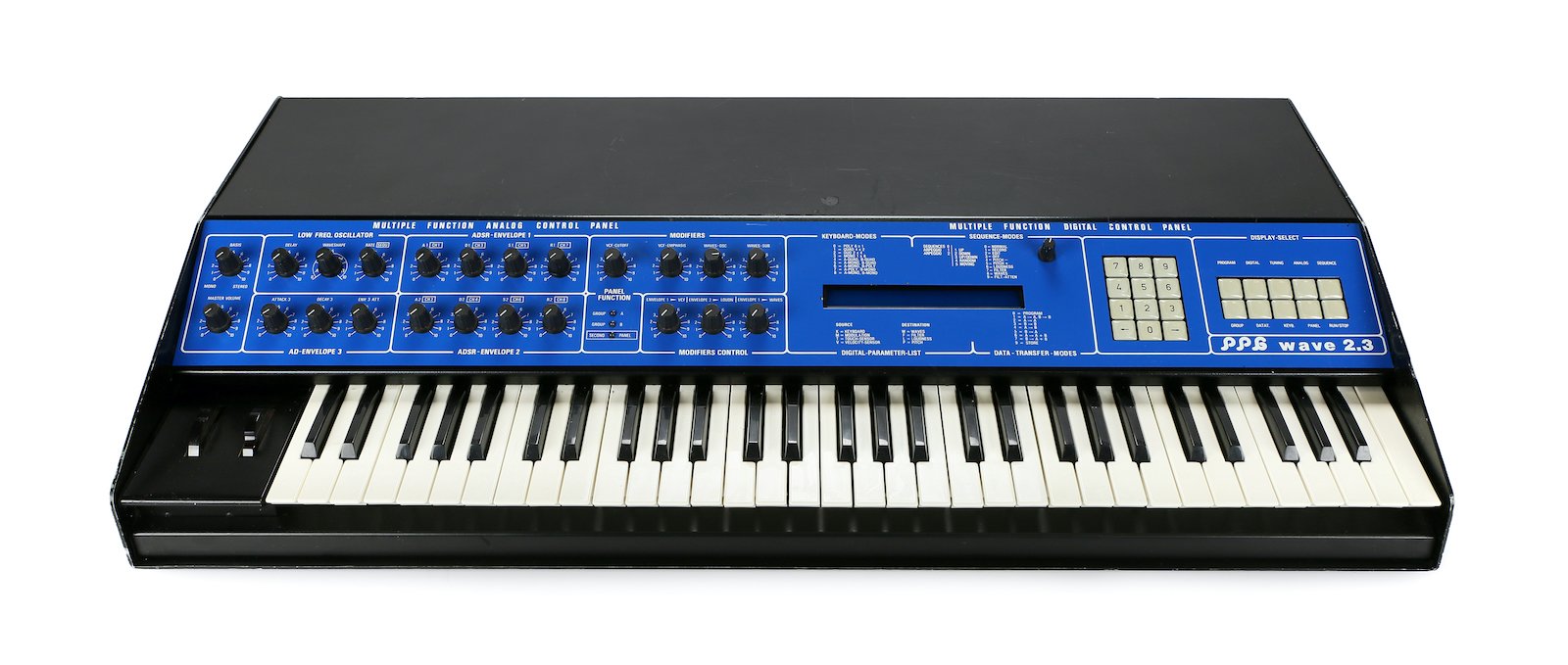
The instrument became a hit, and throughout the 1980s it was used in countless productions of a diverse variety of artists ranging from Stevie Wonder and David Bowie to Depeche Mode and Tangerine Dream (the latter actually assisted PPG during the development of the synthesizer). Throughout the 1980s PPG continued to update Wave, outfitting it over time with MIDI functionality, expanded polyphony, and higher resolution. However, growing competition from other digital synthesizers such as Yamaha's DX7 and Korg's DW-8000 contributed to a significant decline in sales, and in 1987 the company shut down the production.
But every end is a new beginning, and in the same year, Wolfgang Palm joined forces with his long-time distributor Wolfgang Düren to form Waldorf Music. Waldorf's first product was the Microwave—a rack-mountable wavetable synthesizer that utilized the same concepts as used in Wave, but equipped with a new Curtis CEM analog filter chips that contributed to the instrument's distinct sonic quality. While Waldorf created a number of other instruments since the release of the first Microwave (Microwave II came out in 1997, and the following year Microwave XT arrived), it is fair to say that wavetable synthesis remains one of the core focuses in most, if not all of the company's creations to this day. Among them are such revered instruments as Blofeld, Iridium, M, and of course, the current flagship Quantum.
Another important brand that implemented some form of wavetable synthesis early on was the American manufacturer Ensoniq. The company's initial success came in 1984 with the release of Mirage—an 8-bit, 8-voice polyphonic sampler-synthesizer that could also be configured as a wavetable synth via an alternative 3rd-party operating system. The instrument featured sixteen PCM-based or thirty-two wavetable oscillators, a resonant 4-pole Curtis filter, extensive MIDI integration, multi-sampling, and multitimbrality.
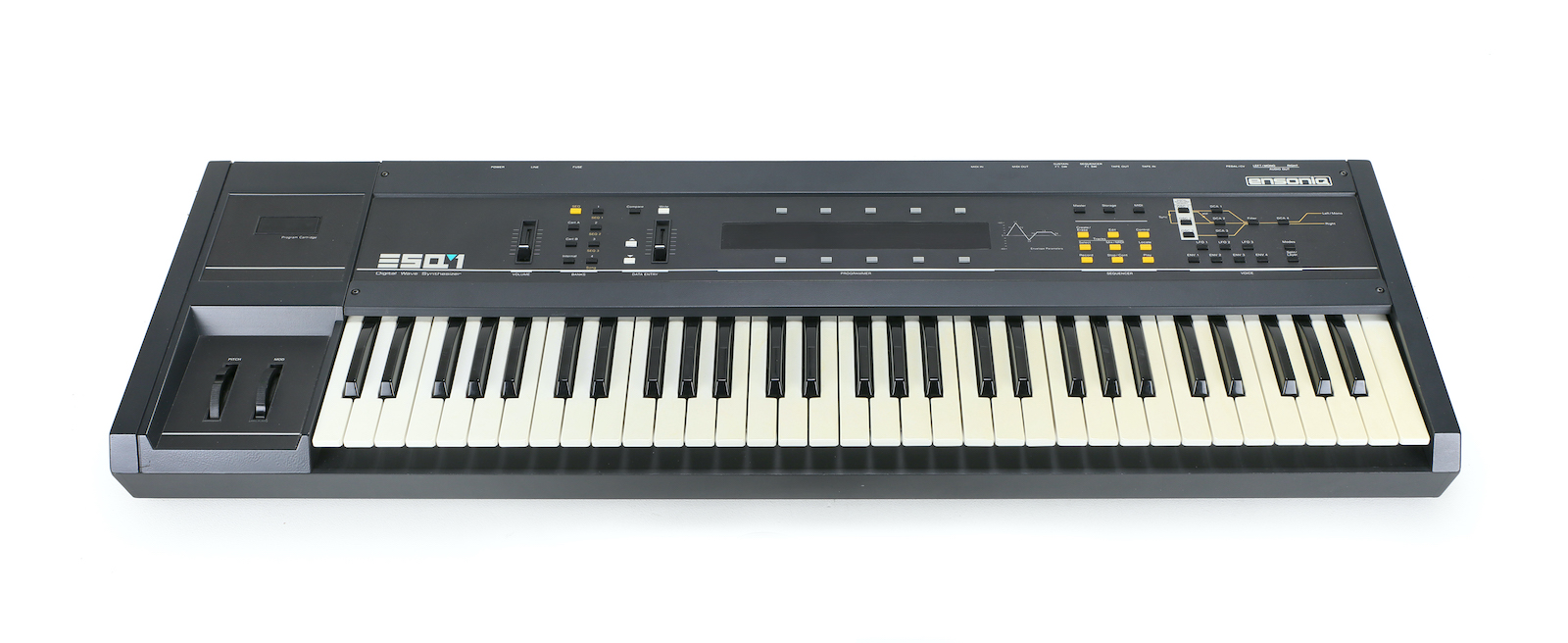
In 1985 Ensoniq released another instrument, ESQ-1 (pictured above). Marketed as a digital wave synthesizer, the ESQ-1 included a custom wavetable chip developed by the company, an analog resonant filter, three envelopes, and three LFOs freely assignable to a variety of parameters. Moreso, ESQ-1 was equipped with a built-in 8-track sequencer, and a deep MIDI integration—rendering it one of the earliest workstation synthesizers. After the ESQ-1 Ensoniq continued to develop synthesizers up until the dissolution of the brand in 2002, however, their focus was being aimed more and more toward sample-based instruments, and not as much wavetable synthesis.
Of course, the discussion of the origins of Wavetable synthesis would be incomplete without a mention of the Prophet VS—a distinct breed of the method first formulated by Chris Meyer of Sequential Circuits. The "VS" in the name of the instrument stands for "vector synthesis", and it essentially means a two-dimensional interpolation between multiple waveshapes, thus allowing for even more complex timbre morphing. For this, the instrument was equipped with a joystick—a memorable element of the interface that provided its users with means to manually scan through the waves across the X and Y axes. The groundbreaking design of the Prophet VS makes it one of the most interesting and unconventional synthesizers to this day.
Modular Wavetable Synthesis
With a revival of interest in modular synthesis, accompanied by an emergence of a growing number of new synth brands and manufacturers that cater to the format, it is only natural that some would attempt to implement wavetable synthesis in their modules. An early example of this was created by now-defunct Mutable Instruments in the Braids macro-oscillator module, which was eventually replaced with a reworked version called Plaits. Other venerable examples include the Industrial Music Electronics Piston Honda, Intellijel Shapeshifter, ZIQAL Dimension, 4MS Spherical Wavetable Navigator, ALM Busy Circuits MCO, and the previously mentioned Scanned from Qu-Bit.
Interestingly, each of these modules offers a radically different perspective on wavetable synthesis which above all manifests in a very unique workflow and a distinct sonic range. Importantly, the core disposition of modular synthesis allows one to dream up a seemingly infinite range of configurations, making it possible to create unique analog-digital hybrid instruments and explore all sorts of applications for the method including variation mentioned earlier, such as vector synthesis, dynamic wavetable generation, and novel modulation systems.
Pros and Cons
Wavetable synthesis has many advantages over traditional analog sound design methods, primarily an extended, and even more importantly extendable sonic range, as well as the flexibility to be used in a wide range of musical contexts. Being able to easily morph between potentially very different waveshapes gradually and instantaneously makes wavetable synthesis as fitting for generating complex and evolving textures, as for precise percussive sequences.
However, as it is a digital form of synthesis it is prone to aliasing, which again can serve as a good or a bad thing depending on the context. For example, the low resolution of the PPG Wave's oscillators is not necessarily a weakness. Combined with analog filters, it defined the unique sound of the instrument. Another potential downturn of the approach is that some may perceive the sound of wavetable oscillators as too clinical because of the lack of variance in digital waveforms. That said, modern synthesizer manufacturers have developed a number of recipes and tricks that allow digital sound sources to appear as lively and animated as analog ones.
All things considered, wavetable synthesis is a very powerful tool for sound design and music production, which is evident from it being a popular choice for many producers and musicians working across a wide variety of genres and styles. It is a great framework for creating unique and complex sounds that would be difficult or impossible to achieve with other forms of synthesis.

